Hard Corps: Marine’s ‘Expeditionary Force 21’ To Be ‘Fast, Austere, & Lethal,’ And Expensive
Posted on
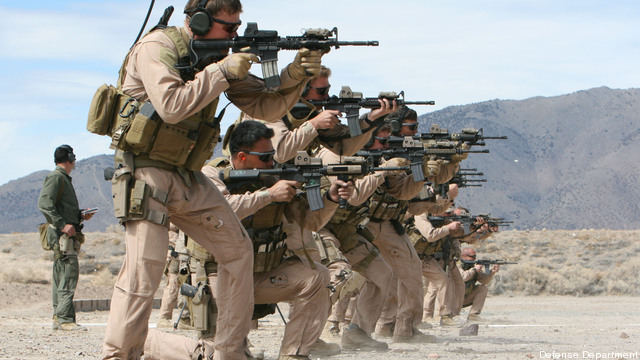
Marine Corps special operators.
WASHINGTON: In a move with major implications for the defense budget, defense contractors, and inter-service politics, the Marine Corps is set to publish a new “capstone concept” — leaked to Breaking Defense — that will guide the entire service for the next decade. From the title on, Expeditionary Force 21 paints an emphatic, uncompromising picture of a future Marine Corps that is “expeditionary… fast, austere, and lethal,” from equipment to training to the mindset of every single Marine. The concept
- calls for major investments in rapid-deployment forces, from helicopter-carried jeeps to high-speed boats — while deemphasizing traditional amphibious vehicles — that can conduct a new kind of long-range amphibious warfare in the face of “anti-access/area denial” threats;
- claims the rapid-response “expeditionary” mission so completely for the Marines that it implicitly competes with the Army’s 82nd Airborne, while conversely ceding long-term and large-scale land operations almost completely to the Army;
- extols the Navy’s new emphasis on cheaper supplements to traditional amphibious warships, from the purpose-built Mobile Landing Platform to LMSR transports jury-rigged with extra command and communications systems; and
- joins the Marines at the hip — or maybe at the ship — with the Navy, the Coast Guard, and, to a lesser extent, Special Operations Command. The Army and Air Force get one mention apiece in the entire 48-page document; special ops gets eight; the Coasties 14; and the Navy, 35.
Marine Corps Expeditionary Force 21 Capstone Concept 12 Mar 2014
While Marine leaders have talked for years about returning to the service’s seaborne and expeditionary roots, “Expeditionary Force 21 marks a significant escalation in this regard,” said Army War College professor Nate Freier. “It is an indication of a clean and unmistakable conceptual break from the Marine Corps’ most recent warfighting past in Iraq and Afghanistan.”
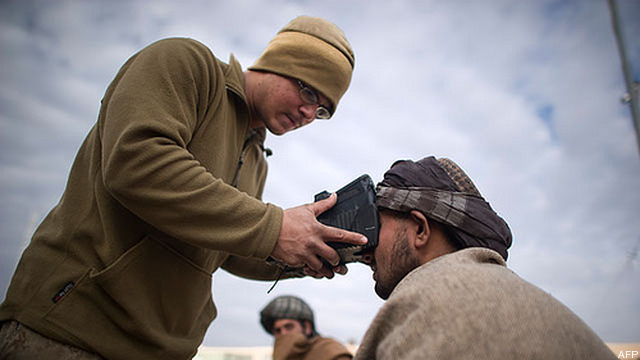
A Marine takes a “biometric” assessment of an Afghan man.
A Plague On Air-Sea Battle & Strategic Landpower
That break with the past is very much in keeping with the administration’s January 2012 Defense Strategic Guidance, which swore off “large-scale, prolonged stability operations.” But in the debate over the post-Afghanistan future of the armed forces, the Marine concept carves its own path between the two main camps. Between the Air Force and Navy-led “Air-Sea Battle” concept and the Army-led “Strategic Landpower” initiative, Expeditionary Force 21 essentially declares a plague on both houses by mentioning neither one — not once.
It’s not an equal-opportunity pox, however. While the Marines have signed on both to Air-Sea Battle and Strategic Landpower, “it was clear all along that they were torn between being a component of landpower and part of the seapower team, [and] Marine resistance has been one of the things hindering the development of an inter-service strategic landpower concept,” said one defense analyst long affiliated with the Army.
“This document hints that maybe the Marines have decided that they have to choose between being part of landpower and part of seapower, and they’ve made their choice,” the analyst said. “This is pretty seamless with Air-Sea Battle.”
Expeditionary Force 21 focuses on the same long-range, high-tech missile threats — to aircraft, ships, and ground forces — that drive Air-Sea Battle, even though it approaches them from a very different angle and with a critique of the (unnamed) “concept developers and policy-makers” who have not “fully considered” or “comprehensively explored” the potential solutions. But Expeditionary Force 21 has little overlap with the ideas in Strategic Landpower. There are mentions of getting better synergy between conventional and special forces; a good bit about low-key engagement with foreign partners around the world — including “regionally oriented” Marine units that look a lot like the Army’s “regionally aligned forces” — and the obligatory mentions of cyberspace and social media, but there is next to nothing about the abiding importance of troops on the ground amongst the people.
In fact, while Expeditionary Force 21 declares the Marines must refocus on expeditionary warfare “without forfeiting our ability to fight …in any large conflict or enduring war,” it effectively cedes any long-term land mission to the Army. Of the “three scenarios spanning the range of likely military operations” that underlie the Marines’ analysis, one is about ongoing peacetime engagement, one “a low-end crisis response” focused on disaster relief, and one “a high-end response structured around a forcible entry scenario.” None of these is a prolonged land campaign. “Forcible entry” means the Marines kick down the door, not that they spend any significant time on the other side. And the entire discussion of organization and logistics makes clear the Marines are thinking mainly of companies, battalions, and brigades operating for three, 15, or 30 days, sleeping in tents and eating MREs, not the months-long, multi-brigade, big-base missions of Afghanistan and Iraq.
“The Navy, Air Force, and Army are optimized to dominate the sea, air, and land [respectively],” the document says. The Marine Corps, by contrast, “is not optimized to dominate any domain. Rather, the Marine Corps is optimized to be expeditionary — a strategically mobile force that is light enough to get to the crisis quickly, yet able to accomplish the mission or provide time and options prior to the arrival of additional forces” — who may well not be Marines.
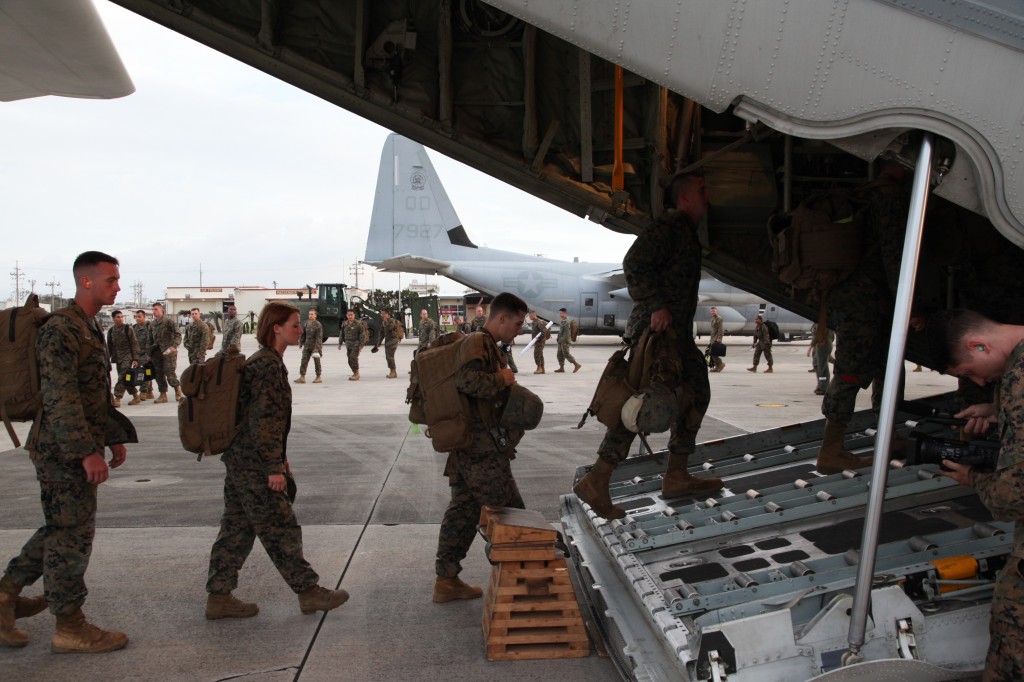
US Marines board aircraft bound for the Philippines to help with disaster relief after Typhoon Haiyan.
The new concept stakes the Marine claim to all “expeditionary” missions so emphatically, in fact, that it rather elbows the Army out of that arena. Most notably, Expeditionary Force 21 says that the Marines will create a battalion-sized “crisis response task force” that can be “fully deployed” from the continental US “within 8-12 hours,” followed by “a ‘suitcase staff’ capable of taking command within 12 hours” and thus form the core of an interservice Joint Task Force. Since such deployment timelines are only possible by air, not by ship, this looks a lot like the Army’s 82nd Airborne Division, albeit without the Army paratroopers.
Throughout, Expeditionary Force 21 repeatedly mentions the Marine Corps’ increasing capability to project power through the air, and to do so from land bases, not just from the sea. The Marines already have a “Special Purpose Marine Air-Ground Task Force” that operates from southern Europe using the V-22 Osprey, whose hybrid “tilt-rotor” design gives it far greater range and speed than Army helicopters, and they plan to create another land-based SPMAGTF for the Middle East. Ospreys flying from Marine bases in Japan were also a big part of the Typhoon Haiyan relief effort in the Philippines.
Then there’s the still-in-testing F-35B Joint Strike Fighter. Both the V-22 and F-35B, significantly, can operate either from ships much smaller than a traditional aircraft carrier or from austere airfields without a full-length concrete runway.
Deploying those ships and finding those bases — if necessary seizing them by force — is central to the Marines’ concept of 21st century amphibious war.
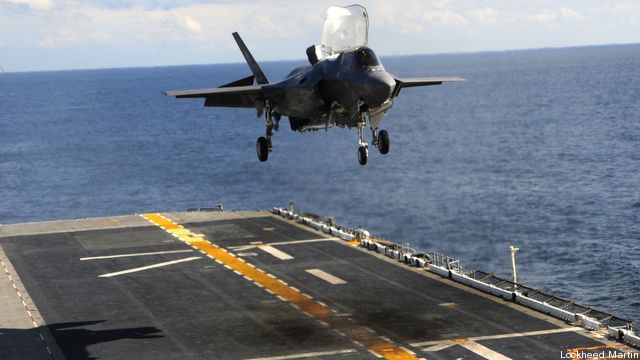
A Marine F-35B Joint Strike Fighter tests its short-takeoff, vertical landing (STOVL) “jump jet” capability.
The 65-Mile Solution
In some ways, the new Expeditionary Force 21 concept is aggressively traditional — and traditionally aggressive. After a decade of land war, the document doesn’t just call for the Marines to return to their roots as a seaborne crisis-response force: It demands “a renewed focus on the Marine Corps’ Title 10 responsibility to be organized, trained and equipped ‘for service with the fleet in the seizure and defense of advanced naval bases.'”
“[With] conflicting claims over portions of the sea and its resources, growing naval competition, and the rise in land-based threats to access,” the concept goes on (invoking China without naming it), “these conditions are remarkably similar to those that existed before and during World War II in the Pacific, but with the added challenge of the increased range and precision of modern sensors and weapons.”
Those long-range, high-precision threats to US aircraft, warships, and land bases are central to the “anti-access/area denial” problem, and it’s here that Expeditionary Force 21 both critiques and complements Air-Sea Battle. The Air-Sea Battle approach to the problem is very much from the outside in, launching long-range strikes from outside the enemy A2/AD zone and stripping it away layer by layer. But the Marine concept argues we can’t always wait to establish air and sea supremacy before moving in. (In fact, US bases in Japan and South Korea would be inside Chinese missile range from the beginning of a conflict).
So, the concept says, why can’t we Marines defend or capture some forward bases where we can set up our own long-range missiles and “‘turn the A2/AD table’ on an adversary. Reinforcing expeditionary advanced bases with long-range strike, anti-ship, and anti-air systems can transform the capability into a sea denial outpost.”
That’s something the influential Center for Strategic and Budgetary Assessments has been advocating for a while. Since the US is usually on the defensive, CSBA argues, we don’t necessarily need to crack open the enemy’s anti-access/area denial system: We and our allies should set up our own A2/AD to keep aggressors from seizing their objectives.
Expeditionary Force 21 makes a good start on this idea, but only a start, said CSBA vice-president Jim Thomas. “The Marine Corps could play a much, much bigger role in air and sea denial with shore-based mobile air defenses and anti-ship missile batteries, as well as offensive mine laying,” he said. “Expeditionary Force 21 hints at this possibility, but doesn’t complete the thought.”
The first question, though, is how to seize these bases in face of modern smart-weapon firepower in the first place. Expeditionary Force 21 makes the point that the clichéd image of amphibious invasion — wave after wave of landing craft and amphibious vehicles coming head-on at the enemy across a broad, flat beach — was becoming obsolete even before the end of World War II, with Marines nimbly landing on narrow beaches on Tinian that the Japanese had not thought worth defending. Compared to their World War II predecessors, modern Marines have much more capability to disperse into small groups and slip through such weak points in the enemy defenses, thanks to modern technologies from small scout drones to communications networks to the V-22.
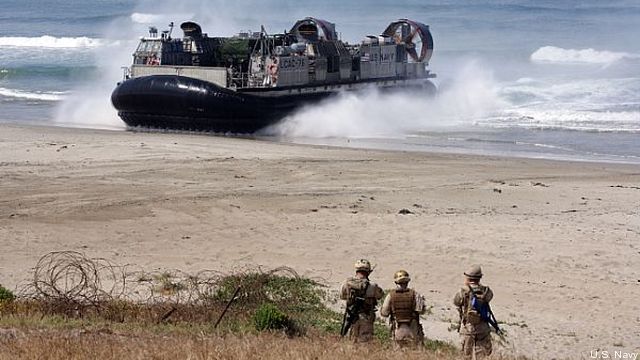
A Marine LCAC (Landing Craft, Air Cushion) hovercraft edges up onto the beach.
But one crucial technology is lagging, the concept says: something the Marine Corps calls “surface connectors” — high-speed vessels, from hovercraft to small boats, that can get Marines and their heavy equipment from ship to shore. Aircraft alone can’t carry enough troops or supplies, let alone armored vehicles, so the bulk of the assault force has to swim instead of fly. But there’s a problem of distance. Traditional amphibious vehicles can launch from ships about five miles offshore; the canceled high-speed Expeditionary Fighting Vehicle might have managed 25; but in the face of modern precision missiles, Expeditionary Force 21 declares, the Navy motherships will need to stay more than 65 nautical miles offshore.
That 65-plus-mile standoff means the Marines and Navy need to develop, not just one new landing craft, but an entire “high-speed, long-range high-capacity system of connectors, amphibious vehicles, and boats.” That might include new hovercraft, “low-observable” stealth boats to sneak up coastlines and rivers, and a whole host of innovative ways to get ashore in a hurry before you get spotted and blown up.
“The type of transformational technology that the MV-22 Osprey has already demonstrated [in the air] needs to be brought to our surface connector fleet,” Deputy Commandant Lt. Gen. Kenneth Glueck said at a recent Senate hearing.
What Glueck didn’t say was how much that would cost. And it’s not just the connectors themselves. Those vessels and the Marines they bring ashore will need covering fire from new precision weapons, from ship-launched drones to smart artillery shells to electromagnetic rail guns, Expeditionary Force 21 says. And they’ll need new communications systems to keep Marines and Navy sailors connected over those 65-plus-mile distances despite the worst that enemy jamming and hacking can do. Expeditionary Force 21 doesn’t just have big implications for how the Marine Corps operates. It will have a big impact on what it buys.
Subscribe to our newsletter
Promotions, new products and sales. Directly to your inbox.
